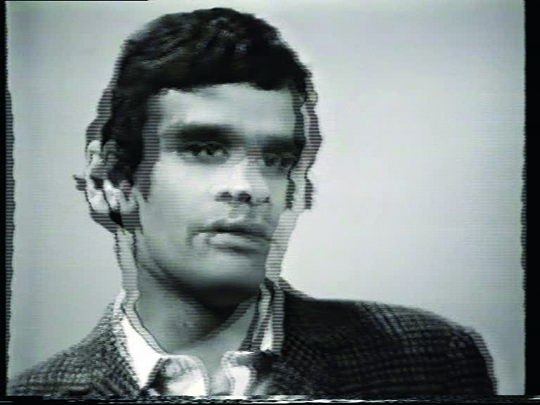OVERLAPPING IMAGES: AN ANALYSIS OF FOUR PORTRAITS
| March 24, 2015 | Post In LEAP 31
TEXT / Zian Chen
“I have seen numerous paintings; they depict things from the beginning of the universe and foretell events to come.” Cao Zhi, Odes , A.D. 227

DESPITE HIS UNTIMELY death, the German artist Harun Farocki leaves behind a monument to our visual epistemology, demanding that future artists remain critical of the regime of images with which they work. But how might one perform such a twofold practice? Or, to take the opposite approach, how can critique invert the boundaries of the image? Better still, how can text make an image?

Like the malleable border between figure and ground, the visual paradox is a facile method by which the image can challenge its own viewing mechanisms. This concern is found in Liu Jianhua: through negation (“without meaning, without content, practically abstract,” he states), his “Untitled” series depicts facial silhouettes that appear ambiguously human and object. Vertical profiles of porcelain faces become confused with horizontal renditions; they are simultaneously shadows of faces and portraits of their material. With this gesture towards the self-portrait, the artist identifies himself with the medium, and the silhouette discovers itself as a sculpture.

In Hao Liang’s work, culturally distinct visual experiences hide behind silk and pigment. In order to uncover a visual transgression by which imagery from different cultural backgrounds adulterates his painting, one must imagine a boundary between figure and ground in his portraiture. Hao borrows cultural cues such as zaoxiang, or “likeness-forming,” from the Chinese painting tradition (its etymology comes from Cao Zhi’s statement, “for an ideal, a form [xiang] is shaped [zao],” now used to describe Chinese portraiture in painting or sculpture), among other sources. His copious use of skeletons points to the other, apparently a legacy of seventeenth-century Dutch still life resembling freeze frame animation. These skeletons indicate his characters’ original appearances without adhering to the realities brought on by death (we can almost hear Farocki’s voice in “Phantom Images”: “The cartoon or animated film is a genre that cannot really represent death”).
The earliest known essay on Chinese portraiture (zaoxiang) resembles much philosophical speculation written before literary criticism: a talented poet had to make use of the dialogic form as a substitute for his own writing. Cao describes Emperor and Empress Ming of the Han dynasty viewing a portrait gallery dedicated to successive rulers to whom they express admiration and allegiance; the only words in the first person discuss portraiture’s potential to represent past events and objects (“depict things from the beginning of the universe”), allowing the painting to elicit thoughts and emotions within the viewer (“foretell events to come”). This is vague, but, as French thinkers Deleuze and Guattari hold in “Percept, Affect, and Concept,” to create is to assemble feelings and mold them into an “art-monument,” which implies that the work “confides to the ear of the future the persistent sensations that embody the event.”(1) Following this lineage, what leads Cao Zhi to discuss the meaning behind portraiture is the question of how the images of rulers were able to hold weight, like the Lumière brothers’ iconic screening of a train entering a station, which viewers took to be real. What is described is simultaneously real and virtual, in the same sense that the Dutch word beeld specifies both an image and an object at the same time. The notion of zaoxiang portraiture, too, pertains to visuality in terms of how an imaginary force might possess virtual intensity. Conversely, it is also about tactility, in that virtuality inscribes and resides within an actual object.

The anamorphic image was in vogue in sixteenth-century Europe; it allows an image to host a threedimensional space within its two-dimensional plane. Under normal circumstances, the skull in Hans Holbein the Younger’s The Ambassadors is distorted: only when looking askance and allowing the figure to recede from its ground does the skull’s form appear. Through this beeld portrayal—both an image and a thing— Holbein hides the concrete beneath the symbolic, creating a space-time that does not belong to the image on the canvas. The skull is distorted with a force of inversion similar to Liu’s porcelain self-portrait: it touches the boundary of visual epistemology in a cryptic double affirmation—image and thing, actual and virtual. This trait of likeness-forming sheds light on Hao Liang’s appropriation of the skeleton, too: it is utilized to resemble the past, which is disguised and projected onto the present and future.

In this realization of Cao Zhi’s theory, where the past endures in the present, duration and memory bring us back to Farocki’s portrait: how might one actualize the intensity of his thinking? Through the echo of likeness-forming, we find an answer. When the image transgresses its modern structure—which would have tactility eliminated—it becomes other.
(1)“Percept, Affect, and Concept,” What Is Philosophy? (trans. Graham Burchell and Hugh Tomlinson), Gilles Deleuze and Felix Guattari, Columbia University Press, New York, 1994, p. 176.


